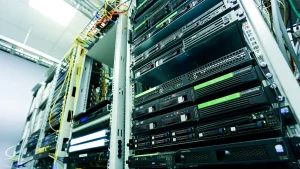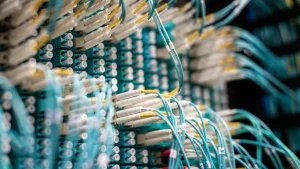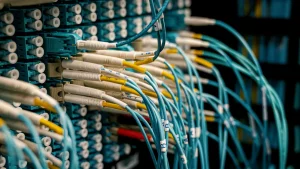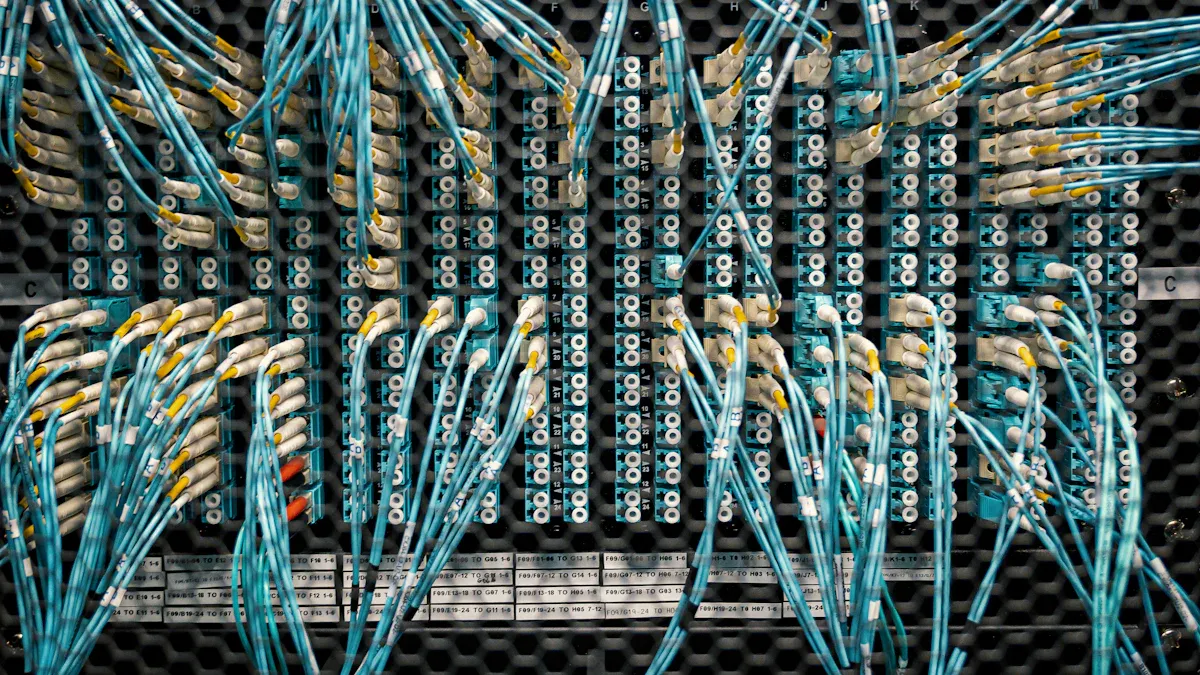
MPO patch panels play a pivotal role in modern data centers by optimizing space and improving fiber management. Over 65% of data centers have adopted MPO connectors to maximize rack efficiency, while hyperscale facilities rely on these solutions for scalable installations. With up to 144 fibers in a single interface, these panels ensure high-density cabling, reducing physical footprint and supporting seamless network expansion.
Key Takeaways
- MPO patch panels save space and help manage fibers better. They can hold up to 144 fibers in a small size.
- Choosing good MPO patch panels boosts performance and makes growth easier. They also make setup simpler and keep networks reliable.
- Affordable MPO patch panels cut cable costs by 25%. They also use 15-20% less energy for cooling, making them a great long-term choice.
Selection Criteria for the Top MPO Patch Panels
Performance and Scalability
High-density data centers demand MPO patch panels that deliver exceptional performance and scalability. Panels with optimized designs, such as 1.5U enclosures featuring ½ RU trays, provide efficient space utilization. These panels can accommodate up to 144 fibers in LC configurations within a compact 1.5U space. Scalability is further enhanced by modular designs, allowing seamless upgrades to higher capacities, such as 400G, without replacing the entire infrastructure.
Performance metrics also highlight the efficiency of these panels. For instance, advanced designs reduce the number of switches by 50% and patch panels by 33%, significantly lowering deployment complexity. This streamlined approach supports faster expansions and ensures high-capacity service level objectives (SLOs).
Durability and Build Quality
Durability is a critical factor in selecting MPO patch panels. High-quality materials, such as robust metal enclosures and precision-engineered connectors, ensure long-term reliability. Panels designed for rugged environments maintain performance under demanding conditions, reducing the risk of downtime. Build quality also impacts maintenance, with well-designed panels simplifying cable management and minimizing wear on connectors.
Compatibility with High-Density Environments
MPO patch panels must integrate seamlessly into high-density environments. Standard 19” or 21” rack compatibility ensures easy installation across various data center configurations. Panels with flexible mounting options, such as 1U, 2U, and 4U sizes, cater to diverse fiber port requirements, ranging from 36 to 288 ports. This adaptability supports the growing trend of rising rack densities, reported by 39% of cloud providers and 36% of colocation operators.
Cost-Effectiveness and Value for Money
Cost-effectiveness remains a top priority for data center operators. MPO patch panels reduce cabling infrastructure costs by 25%, as documented by North American telecom operators. Additionally, these panels lower cooling energy consumption by 15-20%, contributing to operational savings. European operators have demonstrated the value of passive component reuse, achieving an 85% lifecycle extension when upgrading from 40G to 400G modules. These factors make MPO patch panels a cost-efficient choice for long-term investments.
Top 10 MPO Patch Panels for 2025
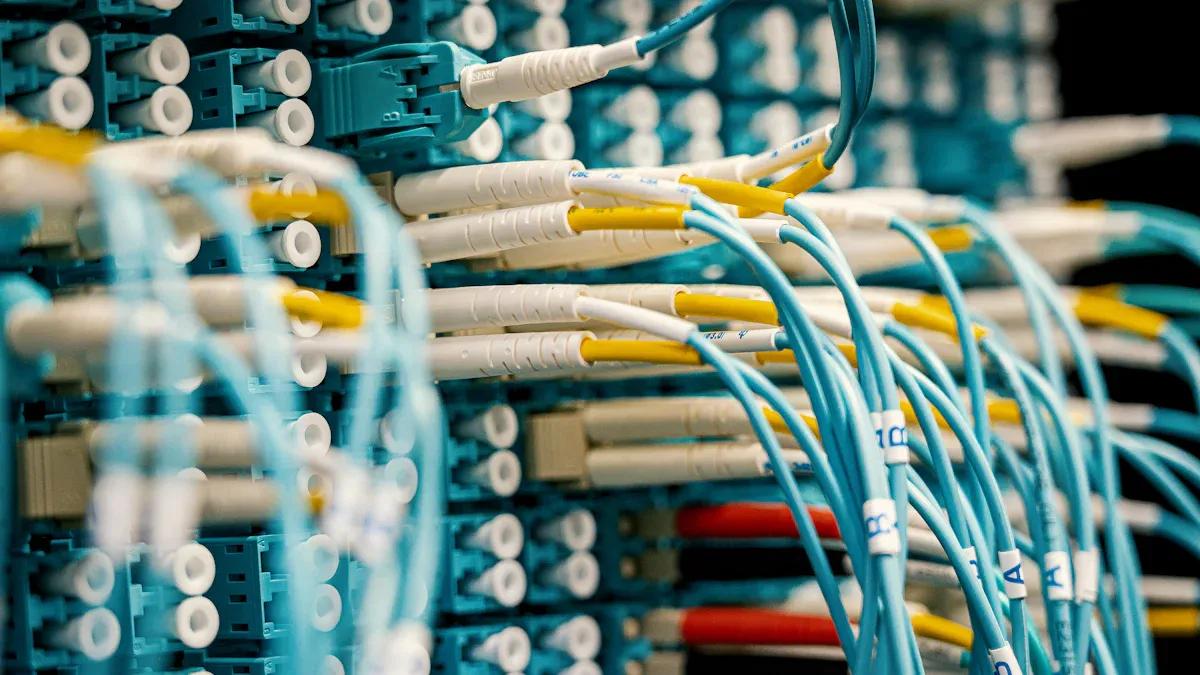
Cisco High-Density Fiber Patch Panel
Cisco’s High-Density Fiber Patch Panel stands out for its exceptional port density and performance benchmarks. Designed for scalability, it supports up to 216 LC ports in a compact 3RU configuration, reducing rack count by up to 75% compared to traditional LGX setups. Its low insertion loss of 0.35 dB ensures minimal signal degradation, while reflectance values of 60 dB for single-mode fibers enhance network reliability. The panel operates efficiently across a wide temperature range, from -40°C to +65°C, making it suitable for diverse environments.
| Specification | Details |
|---|---|
| Port Density | Supports 72 LC Ports (Duplex) in 1RU, 144 LC Ports in 2RU, 216 LC Ports in 3RU. Reduces rack count by up to 75% compared to LGX configurations. |
| Insertion Loss | Single Mode IL 0.35dB (max), Multimode IL 0.35dB (max) |
| Reflectance | Single Mode RL 60dB (max), Multimode RL 20dB (max) |
| Operating Temperature | -40°C to +65°C |
This panel’s high-density design and robust performance metrics make it a preferred choice for hyperscale data centers aiming to optimize space and efficiency.
AFL Hyperscale Ultra-High Fiber Count MPO Patch Frame
AFL’s Hyperscale Ultra-High Fiber Count MPO Patch Frame delivers unparalleled scalability for large-scale installations. It supports configurations exceeding 1,000 fibers, catering to the demands of hyperscale facilities. Its modular design simplifies upgrades, allowing operators to transition seamlessly to higher capacities without replacing the entire infrastructure. The frame’s precision-engineered connectors ensure consistent performance, even under heavy usage, making it ideal for mission-critical applications.
CommScope High-Density Fiber Panel
CommScope’s High-Density Fiber Panel combines innovative engineering with user-friendly features. Its sliding tray design facilitates quick access to connections, reducing maintenance time. The panel supports up to 144 LC ports in a 2RU configuration, optimizing rack space for high-density environments. Its compatibility with both single-mode and multimode fibers ensures versatility, while its durable construction guarantees long-term reliability.
Panduit MPO Fiber Optic Adapter Panel
Panduit’s MPO Fiber Optic Adapter Panel excels in adaptability and ease of use. It features a modular design that supports various configurations, accommodating up to 96 MPO connections in a single panel. The panel’s snap-in adapters simplify installation, while its robust construction minimizes wear and tear. Its compatibility with high-density racks makes it a valuable asset for data centers prioritizing scalability and efficiency.
Tripp Lite Modular Patch Panel
Tripp Lite’s Modular Patch Panel offers a unique approach to scalability with its interconnectable units. This design supports expansion up to 500,000 ports, making it one of the most versatile solutions on the market. Reconfiguring connections takes only 20 seconds, significantly reducing downtime during upgrades. The panel integrates custom software for flexible network management, allowing operators to adapt configurations based on business demands.
| Feature | Description |
|---|---|
| Design | Modular approach with interconnectable units for scalability up to 500,000 ports. |
| Efficiency | Reconfiguration of connections in 20 seconds, significantly faster than traditional methods. |
| Management | Custom software for flexible network management based on business demands. |
This panel’s modularity and efficiency make it a top choice for operators seeking rapid scalability and streamlined management.
Leviton Opt-X HDX Fiber Enclosure
Leviton’s Opt-X HDX Fiber Enclosure combines high-density capabilities with superior cable management. It supports up to 144 LC ports in a 2RU configuration, optimizing space utilization. The enclosure’s sliding trays and integrated labeling system simplify maintenance, while its rugged construction ensures durability. Its compatibility with various fiber types makes it a versatile solution for diverse data center needs.
Corning EDGE™ Solutions Patch Panel
Corning’s EDGE™ Solutions Patch Panel delivers cutting-edge performance for high-density environments. It supports up to 288 fibers in a compact design, reducing physical footprint while maximizing capacity. The panel’s pre-terminated connectors streamline installation, saving time and reducing labor costs. Its low insertion loss and high reflectance values ensure reliable signal transmission, making it ideal for demanding applications.
Siemon LightStack® Ultra High-Density Fiber Enclosure
Siemon’s LightStack® Ultra High-Density Fiber Enclosure sets a benchmark for space efficiency and performance. It supports up to 144 LC ports in a 1RU configuration, making it one of the most compact solutions available. The enclosure’s tool-less design simplifies installation, while its advanced cable management features reduce maintenance complexity. Its compatibility with next-generation network speeds ensures future-proof scalability.
Belden FiberExpress Ultra HD Patch Panel
Belden’s FiberExpress Ultra HD Patch Panel combines high-density capabilities with robust performance metrics. It supports up to 96 MPO connections in a single panel, optimizing rack space for large-scale installations. The panel’s precision-engineered connectors ensure consistent signal quality, while its durable construction guarantees long-term reliability. Its compatibility with various rack sizes makes it a versatile choice for diverse data center configurations.
FS.COM FHD High-Density MPO Patch Panel
FS.COM’s FHD High-Density MPO Patch Panel delivers exceptional performance and reliability. It features low insertion loss values of ≤0.35 dB for MPO connections and ≤0.2 dB for LC connections, ensuring minimal signal degradation. Its high reflectance values enhance network stability, while its wide operating temperature range supports diverse environments.
| Specification | Value |
|---|---|
| Insertion Loss (MPO) | ≤0.35 dB |
| Insertion Loss (LC) | ≤0.2 dB |
| Reflection Loss (MPO) | ≥20 dB |
| Reflection Loss (LC) | ≥30 dB |
| Operating Temperature | 0°C to 70°C |
| Storage Temperature | -40°C to 75°C |
This panel’s high-density design and reliable performance metrics make it a top contender for data centers prioritizing efficiency and scalability.
Comparison Table of the Top 10 MPO Patch Panels
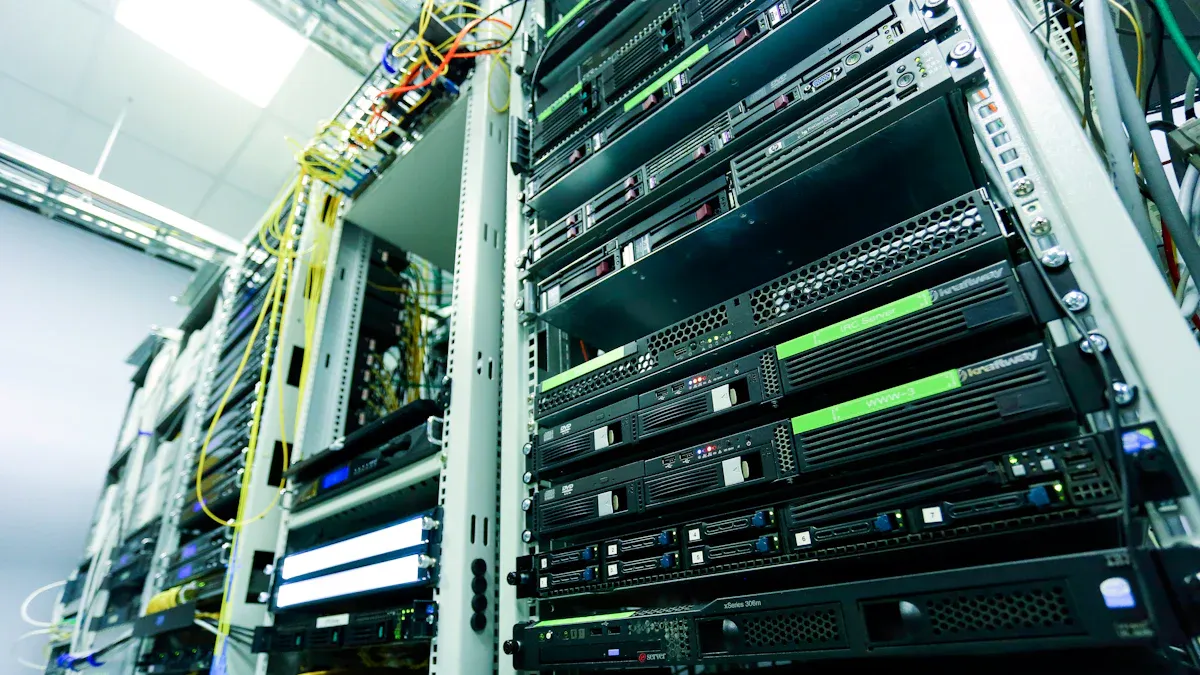
Key Features and Specifications
The top MPO patch panels for 2025 showcase a range of advanced features tailored for high-density data centers. These panels support various fiber connector types, including LC, SC, and MPO, ensuring compatibility with diverse network setups. They accommodate both single-mode and multimode fibers, such as G.652 and OM3, making them suitable for FTTH applications and telecommunication networks.
| Feature | Description |
|---|---|
| Fiber Connector Types | LC, FC, SC, ST, MTRJ, DIN, D4, E2000, MPO |
| Fiber Types | Single mode (G.652, G655), multimode (50/125, 62.5/125, OM3) |
| Application Scenarios | FTTH applications, Telecommunication networks |
| Pros | High-quality raw materials, Competitive pricing, Fast shipping |
| Cons | Limited product dimension details, Potential quality variability by batch |
These specifications highlight the versatility and reliability of the listed MPO patch panels, making them ideal for modern data centers.
Pricing and Value Comparison
Pricing varies across the top MPO patch panels, reflecting differences in features and build quality. Panels like the Cisco High-Density Fiber Patch Panel and Corning EDGE™ Solutions Patch Panel command premium prices due to their exceptional performance and scalability. Meanwhile, options such as FS.COM FHD High-Density MPO Patch Panel offer competitive pricing without compromising on essential features. Operators should evaluate long-term value, considering factors like durability, maintenance costs, and energy efficiency.
Performance Metrics Summary
Performance metrics play a crucial role in determining the suitability of an MPO patch panel. Panels with low insertion loss, such as FS.COM’s FHD model, ensure minimal signal degradation, enhancing network reliability. High reflectance values, as seen in Cisco’s and Corning’s panels, further improve signal stability. Additionally, modular designs and sliding trays simplify maintenance, reducing downtime and operational costs. These metrics underscore the importance of selecting a panel that aligns with specific data center requirements.
Selecting the right MPO patch panel is crucial for optimizing high-density data centers. The listed options excel in scalability, performance, and cost-efficiency, making them ideal for modern infrastructure.
📌 Tip: Evaluate each panel based on your data center’s unique requirements to ensure seamless integration and long-term reliability.
FAQ
What is the primary purpose of an MPO patch panel?
An MPO patch panel organizes and connects multiple fiber optic cables in high-density data centers. It simplifies cable management and enhances scalability for network expansion.
How do MPO patch panels improve data center efficiency?
MPO patch panels reduce physical space requirements by consolidating fiber connections. They also minimize signal loss and simplify maintenance, ensuring optimal performance in high-density environments.
Are MPO patch panels compatible with all fiber types?
Most MPO patch panels support single-mode and multimode fibers, including G.652 and OM3. Compatibility depends on the panel’s specifications and the network’s requirements.
